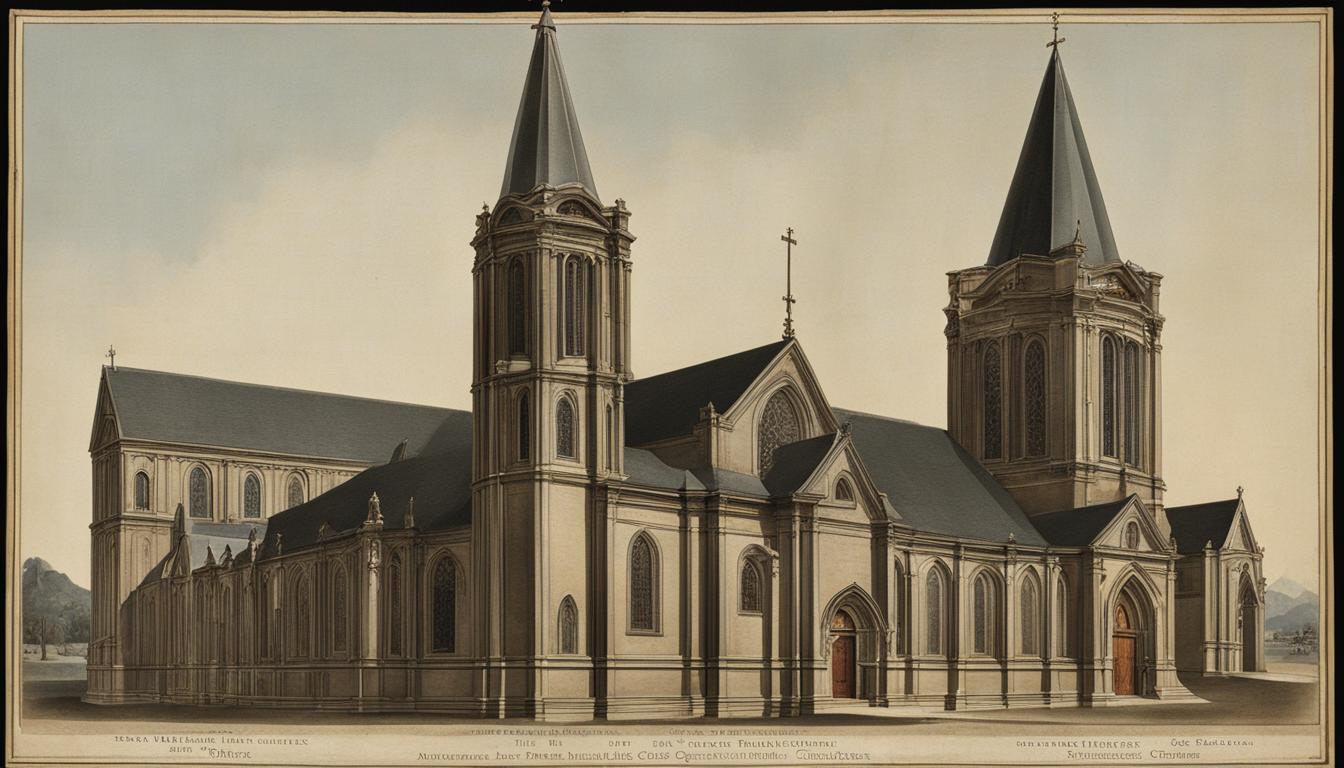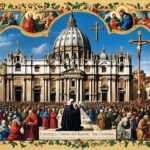The history of the church is a rich tapestry spanning over two thousand years, tracing the development and impact of Christianity from its ancient roots to present-day faith communities. It is a story of faith, resilience, and transformation that has shaped Western civilization and continues to shape the lives of individuals worldwide.
The origins of the church can be traced back to the ministry of Jesus and the teachings of the apostles. Christianity started as a small movement in Judea and quickly spread throughout the Mediterranean world, despite facing persecution and martyrdom.
Over the centuries, the church went through various periods of growth, reform, and theological debates. It became the official religion of the Roman Empire under Constantine, which led to a close relationship between the church and seats of power. The church played a significant role in defining orthodox beliefs and addressing rival beliefs such as Gnosticism and Marcionism.
The Christian Middle Ages saw the marriage of the Christian church and the Roman state, with the pope taking on a central role in the medieval church. Monasticism thrived during this time, providing a way for Christians to seek a deeper spiritual life and driving reform movements to address corruption.
The Reformation period brought about a significant shift in the church’s history, as Martin Luther and other reformers challenged the authority of the Catholic Church and sparked the formation of Protestant denominations. The rise of the Age of Reason led to new schools of thought that challenged traditional beliefs, but also gave birth to evangelical revivals and social service ministries.
In the contemporary era, the church faces various challenges in a globalized world. Interfaith dialogue and social justice issues have become increasingly important, and the church grapples with ongoing debates concerning gender roles, sexuality, and its role in society.
Understanding the history of the church provides a deeper appreciation of its significance and the continued relevance of the Christian faith. Through its rich traditions, beliefs, and practices, the church continues to be a pillar of strength and a source of inspiration for believers around the world.
Key Takeaways
- The history of the church spans over two thousand years, shaping Western civilization and individual lives.
- The origins of the church can be traced back to the ministry of Jesus and the teachings of the apostles.
- The church went through various periods of growth, reform, and theological debates, playing a role in defining orthodox beliefs.
- The Reformation sparked the formation of Protestant denominations, shattering the traditional unity of western Europe.
- In the contemporary era, the church grapples with challenges in a globalized world, including interfaith dialogue and social justice issues.
Origins and Early Years
The early years of the church trace back to its origins in Judea, with the ministry of Jesus and the teachings of the apostles. The early Christians were fervent believers in Jesus as the resurrected Messiah, placing their faith in Him and spreading His message of forgiveness of sins.
“And if Christ has not been raised, your faith is futile; you are still in your sins.” – 1 Corinthians 15:17
Despite facing persecution from both Jewish and Roman authorities, the early Christians remained steadfast in their beliefs. They saw Jesus as a model, embodying sacrificial love and eternal redemption for all ages to come.
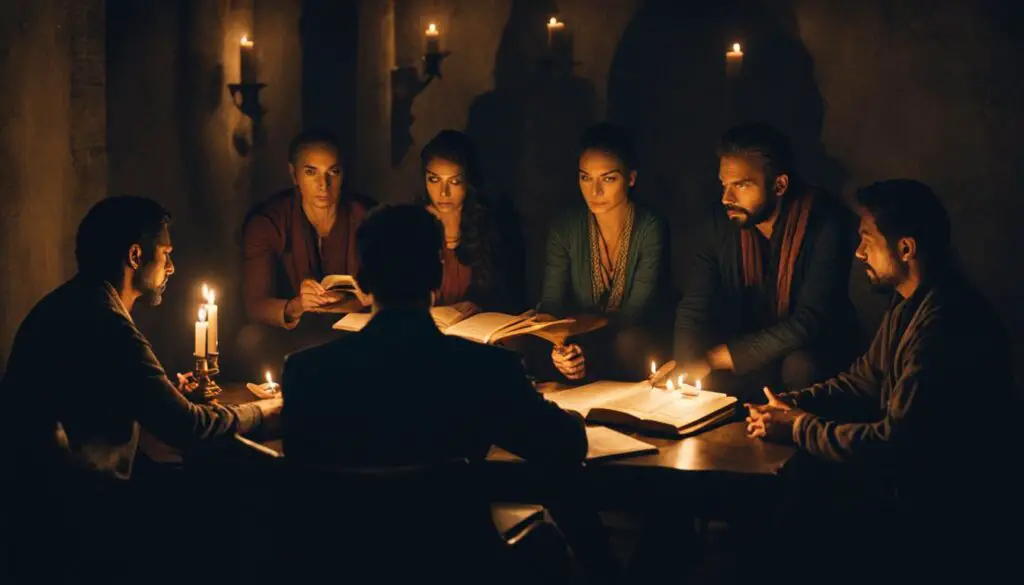
As the early Christians laid the foundation of the church, their unwavering faith in Jesus and the transformative power of His resurrection inspired generations to come. They understood that forgiveness of sins and salvation could be attained through faith in Jesus, setting the stage for the enduring message of the Christian faith.
Age of Catholic Christianity
The Age of Catholic Christianity marked a significant period in the spread of the faith throughout the Mediterranean world. During this time, the early Christians encountered various rival beliefs, including Gnosticism, Marcionism, and Montanism. The church faced these challenges head-on, relying on the apostolic writings and the authority of orthodox bishops to combat these alternative doctrines.
Gnosticism was a prominent belief system that presented a dualistic view of the material and spiritual realms. Its followers believed in the existence of secret knowledge and salvation through enlightenment. The Catholic Church rejected Gnosticism as a deviation from orthodox teachings.
Marcionism, founded by Marcion of Sinope, advocated for a radical separation between the Old and New Testaments of the Bible. It promoted the belief that the God of the Old Testament was fundamentally different from the God revealed by Jesus. The Catholic Church considered this doctrine heretical and a threat to the unity of the faith.
Montanism, led by Montanus, believed in the continuation of prophecy and the imminent return of Christ. This movement emphasized ascetic practices and strict adherence to moral codes. While the Catholic Church acknowledged the value of prophecy, it sought to maintain orthodoxy by carefully discerning genuine prophets from false ones.
Despite facing persecution from the Roman Empire, which viewed Christianity as a threat to its authority, the early Christians remained steadfast in their faith. Many believers endured martyrdom, becoming powerful symbols of devotion and inspiration for others to follow.
“The blood of the martyrs is the seed of the Church.” – Tertullian
The unwavering commitment of the early Christians to spreading the gospel played a pivotal role in the growth and establishment of Catholic Christianity. Their courage in the face of adversity and their dedication to the teachings of Jesus propelled the faith forward during this age.
The Spread of Catholic Christianity
Catholic Christianity experienced rapid growth during this era, extending its reach beyond Judea to the far corners of the Roman Empire. The church established communities of believers in major cities and regions, contributing to the establishment of a widespread and cohesive faith community.
As the church expanded geographically, it also grew in terms of its organizational structure. The authority of the bishops emerged as pivotal in maintaining orthodoxy and preserving the unity of the church. Orthodox bishops were entrusted with the responsibility of ensuring that the teachings and practices of the faith remained true to the apostolic tradition.
In their efforts to combat rival beliefs and preserve the unity of the faith, the Catholic Church relied on the guidance provided by the apostolic writings, including the Gospels and the Epistles. These writings served as a theological compass, providing clarity and guidance in moments of doctrinal confusion.
The commitment of the early Christians to Catholic Christianity and their willingness to defend its teachings and practices were critical in establishing a strong foundation for the future development of the faith. Their perseverance, even in the face of persecution and martyrdom, was instrumental in shaping the course of Christianity in the centuries to come.

Gnosticism, Marcionism, Montanism, orthodox bishops, and martyrdom were all integral elements of the Age of Catholic Christianity. Through a steadfast commitment to orthodox teachings, the early Christians overcame significant challenges and paved the way for the growth and expansion of Catholic Christianity.
Age of the Christian Empire
The age of the Christian Empire marked a significant turning point in the history of Christianity, as the faith became the official religion of the Roman Empire under the rule of Emperor Constantine. This monumental decision altered the course of Christianity and cemented its position as a dominant force in the ancient world.
Constantine’s conversion to Christianity in the early 4th century CE paved the way for the empire’s adoption of the faith, a move that would have far-reaching implications. By establishing Christianity as the official religion, Constantine ushered in an era of religious unity and consolidation throughout the empire.
“In this sign, you shall conquer!” – Emperor Constantine
With the official recognition of Christianity, the church found itself closely intertwined with the seats of power. Church and state became inseparable, shaping the religious and political landscape of the empire. Influence and authority became concentrated within the Christian empire, leading to the formulation of faith for the masses.
To uphold the orthodoxy of Christian doctrine, great councils were convened to address theological issues and define the beliefs of the Christian Empire. These councils, such as the First Council of Nicaea in 325 CE, played a crucial role in combating heretical teachings and establishing a unified understanding of Christianity.
The Council of Nicaea
The Council of Nicaea, held in the city of Nicaea (present-day Iznik, Turkey), is considered one of the most significant gatherings in early Christian history. Led by Emperor Constantine, the council brought together bishops from across the empire to discuss and debate key theological matters.
One of the primary objectives of the Council of Nicaea was to address the teachings of Arius, who propagated the belief that Jesus Christ was a created being and not of the same substance as God the Father. This heretical teaching threatened to divide the Christian Empire and undermine its theological unity.
By the end of the council, the Nicene Creed was formulated, affirming the divinity of Christ and His equality with God the Father. This creed has remained a central statement of faith for Christians ever since, serving as a unifying declaration of orthodox belief.
Monasticism also gained momentum during the age of the Christian Empire, as individuals sought a deeper spiritual life through withdrawal from society. Monastic communities, such as those established by St. Anthony of Egypt and St. Pachomius, emerged as centers of devotion and asceticism. Monasticism became a vital element of the Christian Empire, providing a path for Christians to pursue holiness and introspection.
Impact of the Christian Empire
The age of the Christian Empire left an indelible mark on the course of Christian history. The official recognition of Christianity by the Roman Empire provided the church with a platform for influence, enabling the spread of Christian teachings and values throughout the empire. The close association between Christianity and the power structure of the empire brought both benefits and challenges.
The Christian Empire’s influence extended beyond theological matters. It also impacted the architectural and artistic features of Christian worship, with grand basilicas and magnificent mosaics celebrating the triumph of Christianity. These architectural marvels served as tangible symbols of the faith’s newfound power and privilege.
However, the integration of Christianity into the structures of power also presented its own set of challenges. The close association between church and state raised questions about the purity and integrity of the faith. Some expressed concerns that the Christian Empire’s focus on political power and influence diluted the spiritual essence of Christianity.
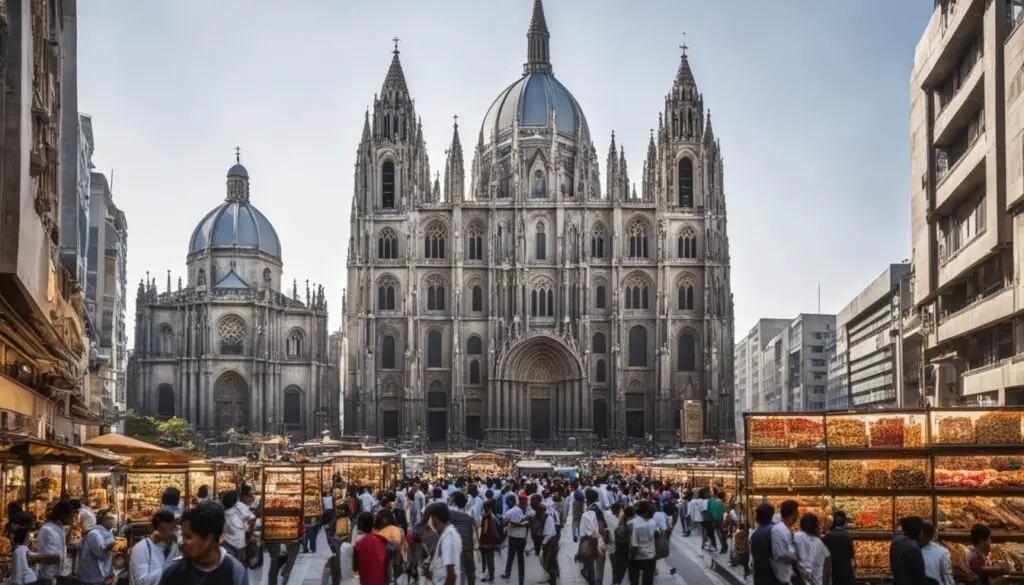
| Key Features | Impact |
|---|---|
| Official religion of the Roman Empire | Christianity gained legitimacy and widespread influence |
| Convening of great councils | Establishment of orthodox beliefs and suppression of heretical teachings |
| Emergence and growth of monasticism | Provided a path for spiritual devotion and introspection |
The Christian Middle Ages
The Christian Middle Ages marked a significant period in the history of Christianity, characterized by the marriage of the Christian church and the Roman state. This era witnessed both spiritual and political developments that shaped the medieval church in profound ways.
In the Eastern Roman Empire, known as the Byzantine Empire, a mystical piety thrived under orthodox emperors until the fall of Constantinople in 1453. The Byzantine Empire served as a stronghold of Christian faith and culture, preserving ancient knowledge and art, while also facing external threats.
Meanwhile, in the West, the pope played a central role in building the medieval church upon the ruins of the fallen Roman Empire. The papal authority grew, and the pope became a significant figure in both spiritual and political matters. Papal authority extended over monarchs and governed the affairs of the church, exerting influence over various kingdoms and territories.
Monasticism played a crucial role in both the Eastern and Western regions of the Christian Middle Ages. Monks and nuns sought a life of devotion and withdrawal from the secular world. They focused on prayer, contemplation, and charitable works, providing spiritual and social guidance to the people.
During this time, corrupt practices and abuses within the church sparked reform movements. These movements emerged to address the need for spiritual renewal and to bring the church back to its biblical principles. Prominent reformers, such as St. Francis of Assisi and St. Benedict of Nursia, emphasized simplicity, poverty, and humility, inspiring others to follow their example.
The Christian Middle Ages laid the foundation for the development of the modern church. It witnessed the consolidation of papal authority, the flourishing of Byzantine spirituality, the promotion of monasticism, and the emergence of reform movements. These elements continue to shape Christianity today.

Age of the Reformation
The Reformation period, marked by an era of immense change, brought about a seismic shift in the history of the church. Led by influential figures such as Martin Luther, the Reformation challenged the authority of the Catholic Church and ignited a movement that altered the religious landscape of Western Europe.
The central figure of the Reformation, Martin Luther, was a German monk and theologian. In 1517, Luther famously nailed his Ninety-Five Theses to the door of the Castle Church in Wittenberg, criticizing the Catholic Church’s sale of indulgences and advocating for theological reforms. This act became a catalyst for widespread dissent and inquiry.
“Here I stand, I can do no other.”
As the Reformation gained momentum, it shattered the traditional unity of Western Europe and gave birth to various Protestant denominations. The quest for religious pluralism and the freedom to interpret the Bible led to the formation of diverse theological perspectives and distinct denominational traditions.
The Rise of Denominations
During this period, Protestantism emerged as a distinct branch of Christianity. The reformers, each with their unique theological emphasis, spread their teachings and gathered followers who embraced these new ideas. The movement was characterized by a commitment to sola scriptura, the belief that the Bible held ultimate authority in matters of faith and practice.
The Reformation also led to clashes between Catholic and Protestant groups, resulting in religious wars and political conflicts. The Thirty Years’ War, a devastating conflict in Europe, highlighted the deep divisions that emerged between the Catholic Church and the emerging Protestant factions.
Meanwhile, the Catholic Church initiated its own reforms in response to the Reformation through the Council of Trent (1545-1563). This council addressed issues raised by the reformers and reaffirmed Catholic doctrinal positions, while also seeking to mitigate corruption within the church.
In this dynamic era, religious fervor spread across Europe, with missionaries from both Catholic and Protestant traditions venturing into new territories to evangelize and establish their denominational presence.
| Key Figures of the Reformation | Denominations and Movements |
|---|---|
| Martin Luther | Lutheranism |
| John Calvin | Calvinism |
| Huldrych Zwingli | Zwinglianism |
| John Knox | Presbyterianism |
| Anabaptists | Anabaptism |
| Anglican Church | Anglicanism |
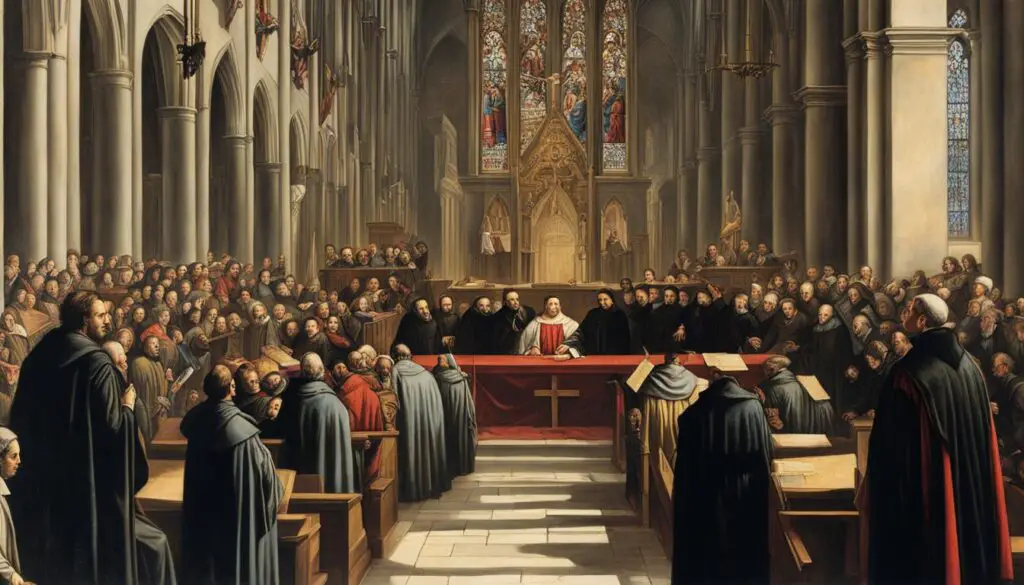
The Reformation not only had theological implications but also laid the foundation for the concept of the church as separate from the state. This separation, known as the principle of “separation of church and state,” became a crucial aspect of religious and political discourse in subsequent centuries.
The Age of the Reformation was a transformative period in the history of Christianity, shaping the development of religious thought, encouraging religious pluralism, and giving rise to distinct denominational traditions that continue to have a profound impact on the Christian faith to this day.
Age of Reason and Revival
The Age of Reason marked a significant shift in the intellectual climate, challenging traditional Christian beliefs. However, Christians responded with fervent evangelical revivals that aimed to restore faith to public life and revive the spiritual fervor of believers.
One of the key movements during this period was Pietism, which originated in Germany and emphasized personal conversion and a heartfelt faith. Pietists sought to bridge the gap between head knowledge and heart experience, emphasizing the need for a personal relationship with God.
“The Age of Reason may question our beliefs, but it cannot silence our faith. We shall rise, united and revived, to proclaim the power of God’s love.”
The Methodist movement led by John Wesley also played a crucial role during the Age of Reason. Wesley’s emphasis on personal piety, moral living, and social justice resonated with many seeking a deeper spiritual experience. Methodism grew rapidly, with passionate preachers traveling from town to town to spread the message of salvation.
The Great Awakening in the American colonies was another significant revival movement during this time. Led by George Whitefield and Jonathan Edwards, this movement focused on powerful preaching, personal conversion, and a renewed commitment to biblical truths. The Great Awakening revitalized the Christian faith and had a profound impact on shaping American spirituality.
Amidst these revival movements, Christians also recognized the growing social needs of industrialized societies. Inspired by their faith, they established various social service ministries aimed at caring for the disadvantaged, alleviating poverty, and promoting education.
The church sought to maintain relevance and exert a moral influence in the midst of changing societies. By embracing both spiritual revival and social responsibility, Christians aimed to demonstrate the transforming power of God’s love in practical ways.
Inspiring Quotes:
“Revivals are the spring rains that bring life to a parched land. Let us open our hearts to the rains of God’s grace and experience a revival of faith, hope, and love.”
“The Age of Reason may question our beliefs, but it cannot silence our faith. We shall rise, united and revived, to proclaim the power of God’s love.”
Age of Progress
The Age of Progress marked a significant era in the history of Christianity, characterized by the active involvement of the church in missions and social service ministries. European Christians embarked on missions to spread the Christian faith to distant lands, while also addressing the social needs of their own communities.
During this time, European nations established colonies and explored new territories, and along with the explorers came missionaries who sought to bring Christianity to indigenous peoples. These European missions had a profound impact on the spread of Christianity globally, establishing churches and Christian communities in various parts of the world.
One notable example of European missions during this period is the work of Jesuit missionaries in Asia, particularly in China and India. These missionaries played a key role in introducing Christianity and European culture to these regions.
In the words of Saint Francis Xavier, a prominent Jesuit missionary, “I want to be either a living witness or a martyr of Jesus.”
Alongside their missionary efforts, the church also engaged in social service ministries to address the pressing needs of their own communities. This included initiatives such as providing education, healthcare, and support for the poor and marginalized.
While the Roman Catholic Church defended its faith against modern challenges, Christianity gradually lost its position as the dominant cultural force in the Western world. The rise of secularism and changing social attitudes posed new questions about how Christians could exert moral influence in pluralistic societies.
The Impact of European Missions
| Missions | Location | Key Figures |
|---|---|---|
| Spanish Missions | North America, Central America, and the Caribbean | Junípero Serra, Bartolomé de las Casas |
| Portuguese Missions | South America, Africa, and Asia | Francisco Xavier, Antonio Vieira |
| Jesuit Missions | Asia, Africa, and the Americas | Francis Xavier, Matteo Ricci, Roberto de Nobili |
The Age of Progress highlighted the church’s adaptability and willingness to engage with the changing world. As Christianity expanded its influence globally, it faced both opportunities and challenges in preserving its moral and spiritual impact.
Age of Ideologies
In the Age of Ideologies, Christianity confronted new challenges and underwent significant shifts in response to the rise of secularism and the worship of new gods such as the state, party, and individual rights. The church faced criticism and recognized the need for spiritual renewal in order to adapt to the changing world.
The denominations found themselves embroiled in intense theological debates as they grappled with the questions and criticisms raised by secular ideologies. These debates sparked a hunger for apostolic experiences and a deeper connection with the foundations of the faith.
After World War II, Christian leadership in the Third World emerged as a beacon of hope for the future of the faith. Third World Christianity brought fresh perspectives and vibrant expressions of belief, offering a renewed vitality to the global Christian community.
Christianity responded to the challenges of the Age of Ideologies by embracing cultural adaptations and exploring new ways to engage with diverse contexts. This period marked a time of introspection and redefinition, as the church sought to reconcile its timeless message with the demands of a rapidly changing world.
Secularism and Religious Criticism
Secularism, the separation of religion and state, emerged as a dominant ideology during the Age of Ideologies. It challenged traditional religious authority and sought to replace God-centered beliefs with human-centered ideals. Christianity faced criticism from secular thinkers who viewed religion as outdated and harmful.
“Religion is the opium of the people.” – Karl Marx
The church responded to this criticism by engaging in intellectual debates and defending the relevance and value of religious belief in a secular world. Christian thinkers and theologians sought to demonstrate the compatibility of faith and reason, addressing the concerns raised by secular ideologies.
Religious Renewal and Adaptation
Recognizing the need for spiritual renewal, Christianity underwent periods of introspection and reform. The church sought to breathe new life into its teachings and practices, making them relevant and meaningful to the changing times.
The exploration of new forms of worship, theological interpretations, and expressions of faith became crucial in this age. Christians sought to invigorate their spiritual lives and engage with the contemporary world in a way that was true to their beliefs.
Third World Christianity: A Beacon of Hope
Christian leadership in the Third World played a pivotal role in shaping the future of the faith. Churches in Africa, Asia, and Latin America offered new perspectives, cultural expressions, and vibrant faith experiences.
Third World Christianity revitalized the global Christian community, challenging Western-centric interpretations and bringing a fresh wave of spiritual vitality. It demonstrated the adaptability and enduring relevance of Christianity in a variety of cultural contexts.
| Key Characteristics of the Age of Ideologies | Examples |
|---|---|
| Secularism | Rise of secular ideologies and the separation of religion and state |
| Religious Criticism | Challenges to traditional religious beliefs and practices by secular thinkers |
| Renewal and Adaptation | Exploration of new forms of worship and theological interpretations |
| Third World Christianity | New perspectives and vibrant expressions of faith from non-Western contexts |
Contemporary Issues and Challenges
In the ever-changing landscape of the contemporary era, the church faces a multitude of complex issues and profound challenges. As the world becomes increasingly interconnected through globalization, Christians from diverse cultural backgrounds are coming together, creating a pressing need for interfaith dialogue and the cultivation of understanding and cooperation among different religious communities.
The church also grapples with social justice issues, recognizing the urgent need to address systemic inequalities and work towards a more equitable and inclusive society. Rooted in the principles of compassion and solidarity, the church seeks to actively engage in efforts that promote social justice, advocating for the rights of the marginalized, and striving to create positive change in the world.
Moreover, contemporary Christianity is marked by ongoing debates on various pressing topics. Discussions around gender roles, sexuality, and the role of the church in society challenge long-held beliefs and spark thought-provoking conversations within faith communities. These debates, while complex, provide an opportunity for growth, self-reflection, and a deeper understanding of the diverse perspectives within the church.
Despite the challenges it faces, the church remains committed to its mission of spreading love, compassion, and inclusion. Through engaging with contemporary issues, the church strives to navigate these complexities and live out its values of justice and mercy in the world.
Conclusion
Church history provides a fascinating and enlightening journey through the development of Christianity, starting from its ancient origins and continuing to the present day. By exploring the key moments, influential figures, and transformative movements, we gain a comprehensive understanding of how the faith has shaped the course of history.
The impact of Christianity on Western civilization cannot be overstated. From the establishment of the official religion of the Roman Empire to its influence on art, architecture, and the development of scientific thought, Christianity has left an indelible mark on our society.
But the influence of the church extends far beyond the Western world. Christianity has touched the lives of countless individuals and communities worldwide, offering solace, guidance, and a sense of purpose. Its teachings of love, forgiveness, and compassion continue to inspire believers and motivate acts of charity and service.
By delving into the history and teachings of the church, we gain a deeper appreciation of its significance and relevance in our lives today. It serves as a reminder of the enduring power of faith, the strength of community, and the transformative impact that an ancient belief system can have on the modern world.
FAQ
What does church history encompass?
Church history encompasses the development of Christianity over the last two thousand years, from its origins with Jesus and the apostles to the present day.
How did the early Christians spread their message?
The early Christians spread their message of forgiveness of sins through faith in Jesus, even in the face of persecution from Jewish and Roman authorities.
What challenges did Catholic Christianity face in its early years?
Catholic Christianity faced challenges from rival beliefs like Gnosticism, Marcionism, and Montanism. It relied on the authority of orthodox bishops to combat these beliefs and experienced persecution from the Roman Empire.
Who made Christianity the official religion of the Roman Empire?
Constantine made Christianity the official religion of the Roman Empire, leading to the church’s close relationship with the seats of power and the formulation of faith for the masses.
What were some significant movements during the Christian Middle Ages?
The Christian Middle Ages saw the marriage of the Christian church and the Roman state, with mysticism thriving in the East and the pope taking on a leadership role in the West. Monasticism and reform movements also played significant roles during this time.
How did the Reformation impact the church?
The Reformation, sparked by Martin Luther and other reformers, challenged the authority of the Catholic Church and led to the formation of Protestant denominations. It shattered the traditional unity of western Europe and introduced religious pluralism.
What characterized the Age of Reason and Revival?
The Age of Reason brought new schools of thought that challenged traditional Christian beliefs. In response, Christians initiated evangelical revivals that sought to restore faith to public life. Pietism, Methodism, and the Great Awakening were movements that emphasized personal conversion and preaching.
How did the church adapt during the Age of Progress?
The church actively got involved in missions and social service ministries during the Age of Progress. European Christians sought to spread the Christian faith to distant lands while addressing the social needs of their own communities. The Roman Catholic Church defended its faith against modern challenges and sought to maintain its influence in public life.
What challenges did Christianity face during the Age of Ideologies?
The rise of secularism and the worship of new ideologies challenged Christianity during the Age of Ideologies. Christians faced criticism and saw the need for spiritual renewal. The denominations also grappled with theological debates and a desire for apostolic experiences.
What are some contemporary challenges faced by the church?
In the contemporary era, the church faces challenges posed by globalization, interfaith dialogue, and social justice issues. It strives to understand and cooperate with Christians from different cultural backgrounds while addressing systemic inequalities and maintaining relevance in pluralistic societies.
Why is understanding church history important?
Understanding church history provides a comprehensive appreciation of the development of Christianity and the significant impact it has had on Western civilization. It helps individuals and communities understand the relevance and continuation of the Christian faith in today’s world.




